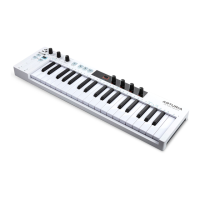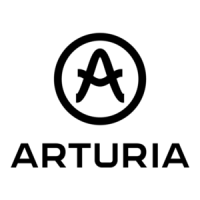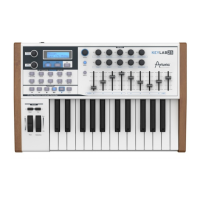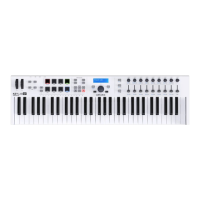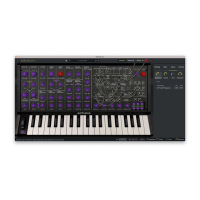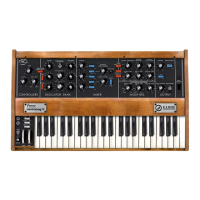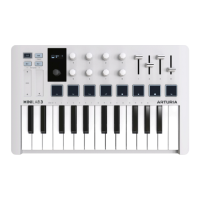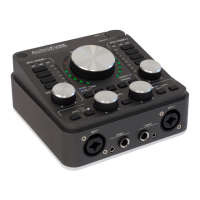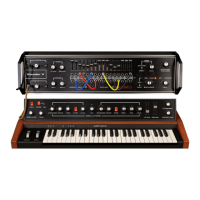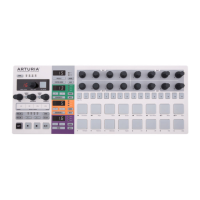Do you have a question about the Arturia KEYSTEP 37 and is the answer not in the manual?
Introduces the KeyStep 37, its capabilities, and guidance on reading the manual.
Covers warnings, product placement, registration, and basic connections.
Details front panel controls, rear connections, and core functions like Sequencer, Arpeggiator, Scales, and Chords.
Connects the device, explains keyboard and touch strip functions, and basic controls.
Guides on selecting, playing, tempo, and time division for sequences and arpeggios.
Explores different arpeggiator modes, octave ranges, and pausing techniques.
Discusses scale selection, chord creation, and strumming patterns.
Details activating and using Chord mode for single notes, chords, and strums.
Covers Transpose, Keyboard Play, and skipping selections for sequences.
Explains Shift functions for MIDI channels, Gate, Swing, Sequence modes, and Scales.
Explains the concept and advantages of step sequencing.
Guides on step recording, entering rests, tying notes, and legato.
Details real-time recording, note replacement, and sequence modification.
Covers saving, clearing, appending, and managing sequences.
Lists arpeggiator features and covers starting the arpeggiator and its modes.
Discusses adding notes in octaves, building multi-octave arpeggios, and pausing.
Covers ratcheting, pitch bend, and other techniques to spice up arpeggios.
Explains operating as a master clock or a slave to external sources.
Details sync input/output types and clock connector information.
Explains how pitch and gate signals work and DAW integration for CV/Gate.
Details the Mod output, its sources, and typical signal routing.
Technical specifications for PITCH, GATE, and MOD outputs.
Explains Control Mode, CC messages, and monitoring CC values.
Managing and editing CC assignments across four banks.
Demonstrates knob connections and controlling MicroFreak parameters.
Covers system requirements, installation, connection, and backing up sequences.
Explains the difference between synced and non-synced operations in MCC.
Managing projects, templates, live editing, and drag-and-drop functionality.
Details data entry, tab selection, sequence window navigation, and note editing.
Configuring MIDI channels, controller settings, sync, CV/Gate, and transport parameters.
Introduces the KeyStep 37, its capabilities, and guidance on reading the manual.
Covers warnings, product placement, registration, and basic connections.
Details front panel controls, rear connections, and core functions like Sequencer, Arpeggiator, Scales, and Chords.
Connects the device, explains keyboard and touch strip functions, and basic controls.
Guides on selecting, playing, tempo, and time division for sequences and arpeggios.
Explores different arpeggiator modes, octave ranges, and pausing techniques.
Discusses scale selection, chord creation, and strumming patterns.
Details activating and using Chord mode for single notes, chords, and strums.
Covers Transpose, Keyboard Play, and skipping selections for sequences.
Explains Shift functions for MIDI channels, Gate, Swing, Sequence modes, and Scales.
Explains the concept and advantages of step sequencing.
Guides on step recording, entering rests, tying notes, and legato.
Details real-time recording, note replacement, and sequence modification.
Covers saving, clearing, appending, and managing sequences.
Lists arpeggiator features and covers starting the arpeggiator and its modes.
Discusses adding notes in octaves, building multi-octave arpeggios, and pausing.
Covers ratcheting, pitch bend, and other techniques to spice up arpeggios.
Explains operating as a master clock or a slave to external sources.
Details sync input/output types and clock connector information.
Explains how pitch and gate signals work and DAW integration for CV/Gate.
Details the Mod output, its sources, and typical signal routing.
Technical specifications for PITCH, GATE, and MOD outputs.
Explains Control Mode, CC messages, and monitoring CC values.
Managing and editing CC assignments across four banks.
Demonstrates knob connections and controlling MicroFreak parameters.
Covers system requirements, installation, connection, and backing up sequences.
Explains the difference between synced and non-synced operations in MCC.
Managing projects, templates, live editing, and drag-and-drop functionality.
Details data entry, tab selection, sequence window navigation, and note editing.
Configuring MIDI channels, controller settings, sync, CV/Gate, and transport parameters.
| Backlight color | Multicolor |
|---|---|
| Backlight buttons | Yes |
| MIDI-keyboard number of keys | 37 keys |
| Product color | White |
| Maximum polyphony (notes) | 8 |
| Display type | LED |
| Interface | USB |
| Depth | 147 mm |
|---|---|
| Width | 550 mm |
| Height | 35 mm |
| Weight | 1600 g |
